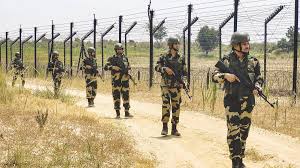
Mizoram Boosts Border Security as 3,000 Refugees Flee Myanmar Conflict

 :
| Updated On: 09-Jul-2025 @ 3:24 pm
:
| Updated On: 09-Jul-2025 @ 3:24 pmSHARE
In response to escalating violence in Myanmar, the Mizoram government has reinforced security along the Indo-Myanmar border. The move follows fierce clashes between two Chin insurgent groups—the Chinland Defence Force–Hualngram (CDF-H) and the Chin National Defence Force (CNDF)—in Khawmawi, a border village on the Myanmar side. The fighting, which erupted on the night of July 5, triggered a humanitarian crisis as civilians began fleeing the conflict zones. Approximately 3,000 refugees have since crossed into India through the Zokhawthar border in Mizoram and taken temporary shelter.
Mizoram Home Minister Pu K Sapdanga confirmed that both the Mizoram Police and the Assam Rifles have been deployed to ensure heightened surveillance and prevent unauthorized crossings. He emphasized the government’s proactive stance in monitoring the situation to maintain law and order along the international border.
To manage the influx of refugees and provide humanitarian assistance, the Young Mizo Association (YMA) has taken a lead role by offering temporary shelter and emergency relief. The Champhai District Deputy Commissioner has also been instructed to coordinate necessary support to ensure the safety and well-being of the displaced persons.
A major concern highlighted by authorities is the requirement for refugees to present valid identification when entering India. However, many fleeing the conflict do not possess necessary documents, as they are escaping sudden and violent hostilities. The Home Minister referenced past incidents where Myanmar soldiers inadvertently crossed into Indian territory, but stated that the current situation is more severe due to the scale and concentration of refugee movement through Zokhawthar.
Both CDF-H and CNDF belong to the Zo nationalist movement and represent the Zohnathlak ethnic group, a community with close cultural and historical ties to the people of Mizoram. Despite this connection, Minister Sapdanga expressed concern over the growing presence of armed ethnic groups near the state’s border and urged refugees to remain in the Zokhawthar area rather than dispersing into interior parts of Mizoram. This would help in monitoring their movement and managing aid more effectively.
The state’s response has been strengthened by the participation of various local organizations, including student unions, churches, and civil society groups, which are working together in the relief effort. The Mizoram government has also appealed to the Central government for additional assistance to cope with the growing humanitarian needs and to secure the border more efficiently.
As tensions continue in Myanmar, Mizoram remains committed to maintaining peace and stability within its own borders. The state government has urged all concerned stakeholders, both within India and across the border, to refrain from actions that could intensify the conflict or put civilians at further risk.
The coordinated approach involving law enforcement, civil society, and humanitarian organizations reflects Mizoram’s efforts to balance security concerns with compassionate treatment of refugees. The situation continues to evolve, and the government is closely monitoring developments while awaiting central support to address the crisis comprehensively.